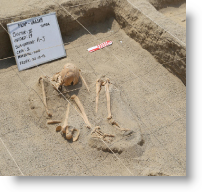 Archaeologists have uncovered remains of a girl who was most probably used as a sacrifice some 1,500 years ago, according to RPP radio.
Archaeologists have uncovered remains of a girl who was most probably used as a sacrifice some 1,500 years ago, according to RPP radio.
The discovery was made in the district of Yautan, 40km inland from Casma in the Ancash region. The remains of the girl were discovered in a tomb by a group of archaeologists and students from the University of Santiago Antunez de Mayolo in Huaraz.
The archaeologists believe the girl could have been sacrificed as an offering to gods of the sea, perhaps as protection against the climate changes caused by the El Niño ocean current.
The team of experts, led by archaeologist Hilder Cruz, believe the burial site is possibly Wari culture, although in excavations a year ago, pots found were from Chavin. Also in Chavin fashion, the site was built at the confluence of two rivers, the Chavin and the Yautan.
The Wari empire spanned much of modern Peru during the 8th and 9th Centuries A.D. Experts say that its capital, Huari, had a population of some 40,000 people, which would have been a major global urban center at the time. Much is still not known about the Wari, which like other pre-Hispanic civilizations, is overshadowed in Peru by the Incas.
The Yautan project, which began two years ago, is being funded by the local Municipality, which is setting aside a small part of the site for private investment in a museum. According to Cruz, several of the archaeology students are also contributing to some of the expenses.





